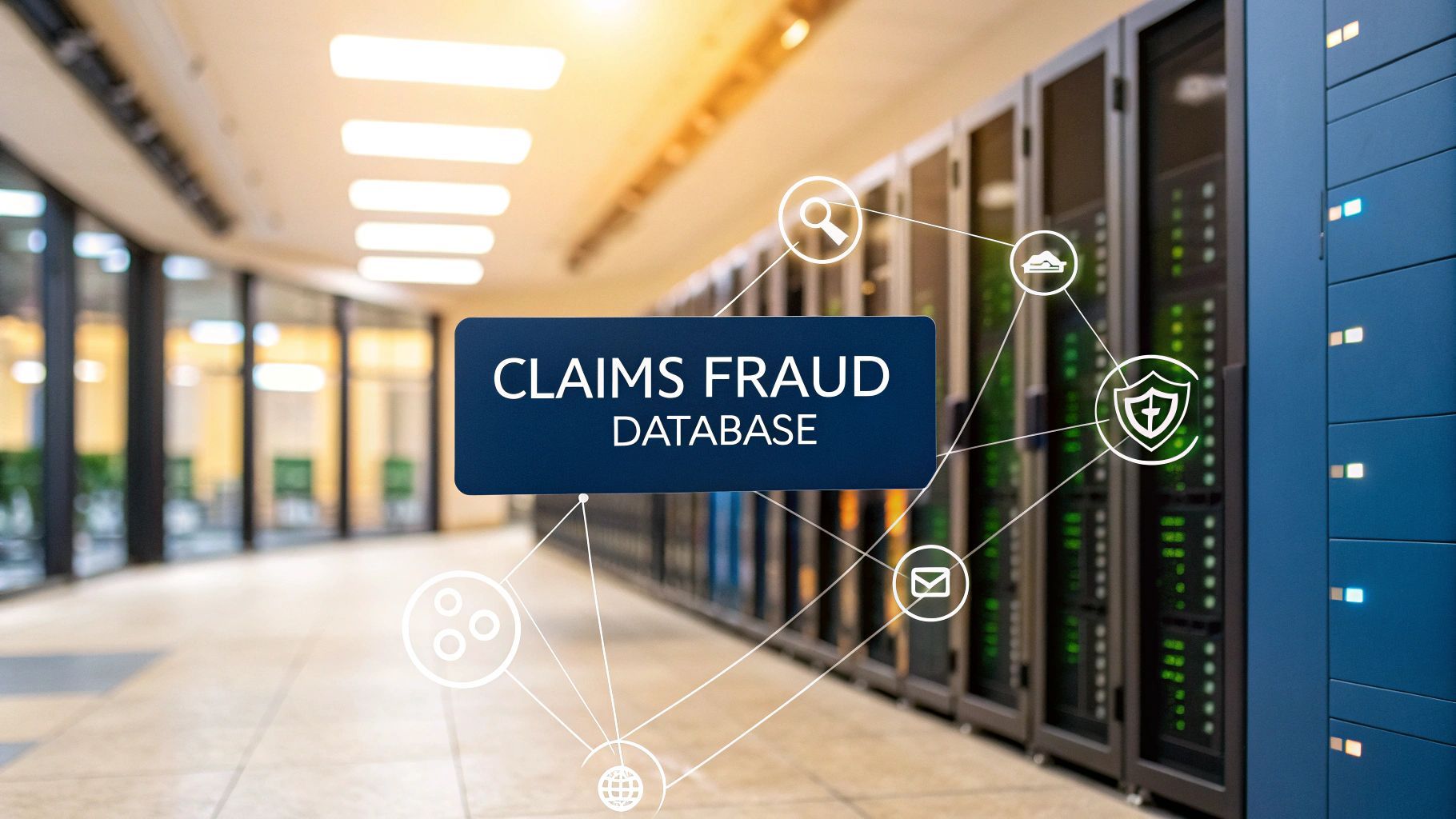Insurance Claims Management Software | Streamline & Combat Fraud
At its heart, insurance claims management software is a digital platform designed to bring order to the chaos of the entire claims lifecycle. It takes everything from the first report of an incident right through to the final payout and automates it, replacing clunky, outdated manual processes. The goal? To improve speed, accuracy, and the ability to spot fraud.
For insurers in the UK, this kind of technology is no longer a 'nice-to-have'. It’s rapidly becoming a core part of staying afloat in a fiercely competitive market where fraudulent claims are a constant threat to profitability and customer trust.
The Rising Challenge of Modern Insurance Claims
Let's be honest, the UK insurance landscape is a tough place to be right now. Providers are drowning in a sea of claims, which piles on immense financial and operational pressure. The traditional way of doing things—shuffling papers, updating spreadsheets, and making endless phone calls—simply cannot keep up.
These old-school methods create massive bottlenecks, send administrative costs through the roof, and leave customers feeling frustrated as they wait for their settlements. The core of the problem is one of scale and complexity; handling a huge number of claims accurately and efficiently by hand is a monumental, if not impossible, task.
This reliance on outdated systems also leaves the door wide open for the industry's most persistent and costly headache: insurance fraud. Trying to verify the legitimacy of every single claim, ensuring its provability , is a constant battle. When your processes are manual and data is scattered across different files and folders, it’s far too easy for fraudulent claims to slip through the cracks. This isn't just a minor issue; it's a deep-rooted problem with far-reaching consequences for everyone.
The Cost of Inefficiency and Fraud
The financial hit from these challenges is staggering. Every single fraudulent or exaggerated claim that gets paid out is a direct loss for the insurer. But those losses don't just vanish into thin air. They get passed on to every other policyholder through higher premiums.
This means honest customers end up footing the bill for the crimes of a dishonest few. It creates a vicious cycle of rising costs that slowly erodes the trust between insurers and the people they're supposed to protect. The cost of insurance fraud to the industry and all of us is immense.
The sheer scale of this is hard to ignore. Insurance fraud costs the UK economy an estimated £1.3 billion annually . That's a figure that directly impacts the premiums we all pay and the final settlement amounts offered by insurers. You can learn more about the market dynamics of insurance claims software on verifiedmarketresearch.com.
A Necessary Shift Towards Technology
Facing these mounting pressures, the industry has finally reached a tipping point. The severe limitations of manual processing, coupled with the huge financial drain from fraud, have made it crystal clear that a new approach is needed. Insurers are now turning to smarter, technology-driven solutions to regain control, sharpen their accuracy, and protect their bottom line.
This is where insurance claims management software steps in as the modern answer to these age-old problems. It's built specifically to tackle these challenges head-on, offering a structured, automated, and intelligent way to manage claims and ensure every step of the process is verifiable and secure.
Right then, let's break down what insurance claims management software really is, without the corporate jargon.
Think of it as the brain and central nervous system for an insurer's entire claims department. For too long, this world has been a chaotic mix of scattered spreadsheets, overflowing filing cabinets, and endless, confusing email chains. This software sweeps all that away and replaces it with one single source of truth.
It’s a digital hub that takes charge of the entire claims journey. From the very first moment a customer reports a loss—the First Notice of Loss (FNOL)—all the way through investigation, assessment, back-and-forth communication, and finally, the settlement and closure.

Every single document, photograph, message, and decision is captured and locked into one secure, easily accessible place. This creates a complete, unchangeable story of the claim, giving adjusters, customers, and anyone else involved a crystal-clear view of its status and history.
Creating an Indisputable Audit Trail
This is where the software really shows its power. It’s all about creating provability . By automatically logging every single action with a timestamp and user details, it builds a rock-solid, chronological audit trail. This isn't just about tidy record-keeping; it's about building a fortress against disputes and fraudulent claims.
If a settlement decision is ever questioned, the insurer can instantly pull up the exact data and reasoning that led to it. This digital footprint proves that all the proper steps were followed and that the final decision was based on hard evidence, not a hunch. That level of documentation is absolutely vital for staying compliant with regulations and confidently defending your decisions.
This meticulous record-keeping is your first line of defence against fraud. It makes it incredibly difficult for criminals to submit false information or tweak details later, because any inconsistency sticks out like a sore thumb in the system's unchangeable log.
A Foundation for Fighting Fraud
Beyond just managing the day-to-day, this software is a game-changer in the battle against insurance fraud—a problem that costs the UK economy billions and affects us all through higher premiums. By corralling all claim data into one ecosystem, the platform can run advanced analytics to spot suspicious patterns that would be completely invisible to the human eye.
For instance, the system might flag subtle connections between what look like unrelated claims, identify repeat claimants with a dubious history, or highlight glaring inconsistencies in the evidence submitted. It flips fraud prevention from being a reactive clean-up job into a proactive strategy.
Instead of trying to claw back money after a fraudulent claim has been paid, insurers can spot the red flags and stop it in its tracks. This doesn't just protect the insurer's bottom line; it helps keep premiums fair and affordable for all the honest policyholders out there.
Key Features That Change The Game in Claims Processing
To really get why insurance claims management software is such a big deal, you have to look past the buzzwords and dig into the tools that make it all work. These aren’t just small tweaks to old processes; they’re powerful features designed to solve the industry’s most stubborn problems, especially the massive challenges of proving claims and spotting fraud.
At its heart, the software brings in structured, automated workflows. Think of them as smart to-do lists that guide adjusters through every single step of a claim, making sure nothing gets missed. This methodical approach is a game-changer for reducing human error and keeping everything consistent, which is crucial for proving every decision made.
A great platform gives you all the tools you need in one place, creating a central hub for the entire claims journey.

This centralisation means that from the first report to the final payout, every action is logged and can be verified, building a rock-solid defence against fraudulent activity.
AI-Powered Fraud Detection
Perhaps the most vital feature today is the use of artificial intelligence. AI-driven analytics work like a highly skilled detective, constantly sifting through data to find suspicious patterns that a person would never catch. This is where the fight against fraud shifts from being reactive to proactive.
These AI systems can:
- Flag anomalies: Spotting inconsistencies in claim details, like mismatched dates, locations, or descriptions of what happened.
- Analyse connections: Uncovering hidden links between claimants, repair shops, or medical providers that might point to organised fraud rings.
- Assess risk scores: Automatically giving each claim a risk score based on hundreds of factors, helping adjusters know which cases need a closer look.
By catching these red flags early, insurers can stop fraudulent payouts before they ever happen. It’s not just about saving money for the company; it helps keep premiums down for honest policyholders by tackling the £1.3 billion annual cost of fraud that hits everyone in the UK.
For example, a system might flag a claim where the photo evidence has metadata showing it was taken weeks before the incident was even supposed to have happened. This kind of digital proof is gold for validating a claim and shows just how technology strengthens the entire process.
Centralised Documentation and Communication
Another game-changing feature is having a single, unified place for all claim-related documents and messages. The days of adjusters digging through scattered emails, paper files, and different messaging apps are over. Now, every photo, invoice, witness statement, and policy document lives in one secure digital file.
This central hub creates an unchangeable, time-stamped record of the entire claim from start to finish. This detailed audit trail is the foundation of provability . If a decision is ever questioned, the insurer has a complete, defensible history of every single action taken. This level of proof is essential for robustly defending against fraudulent or exaggerated claims.
This level of organisation also makes communication a breeze. Integrated tools let adjusters, policyholders, and other parties talk within the platform, so every conversation is logged. This transparency not only speeds up processing times but also makes the customer experience far better, turning a stressful situation into something much more straightforward.
The Financial Impact of Adopting Claims Software
Bringing in new claims management software isn't just an operational tweak; it's a serious financial decision, and one that pays for itself. The benefits run much deeper than just making things run a bit smoother. This technology directly targets some of the biggest costs in the insurance industry, particularly the fraudulent claims that bleed resources and drive up premiums for everyone else.
The most immediate win you'll see is a dramatic drop in administrative overhead. Think about all the repetitive tasks that tie up your best people: manual data entry, sorting documents, and the initial triaging of claims. By automating these jobs, the software frees up your experienced adjusters to concentrate on the complex, nuanced cases that actually need their expertise. This automation speeds up settlement times, which in turn slashes the costs that rack up while a claim remains open.
And then there's the legal side. The meticulous, provable documentation these systems create is a game-changer for cutting down litigation expenses. With a complete, unchangeable audit trail for every single claim, insurers can stand behind their settlement decisions with confidence. This drastically reduces the odds of ending up in a costly legal battle or facing regulatory fines. That rock-solid evidence trail is your financial shield against fraud.
Slashing the Staggering Cost of Fraud
But where this technology really makes its mark is in fraud reduction. Insurance fraud isn't a victimless crime—it costs honest policyholders and the entire UK economy billions. Modern claims software uses smart AI algorithms to sift through claim data, flagging suspicious patterns and inconsistencies that a human analyst could easily miss.
By spotting potential fraud before a payout is made, insurers can prevent millions in losses. This is a world away from the old-school, reactive approach of trying to claw back money after the fact—a process that is notoriously difficult and expensive.
This isn't just about protecting profit margins; it creates a positive ripple effect. With lower fraud losses, insurers can start offering more competitive premiums. That strengthens their position in the market and helps attract new customers. It's a direct line from a smart technology investment to a real commercial advantage, and it benefits all honest customers by keeping premiums in check.
Fuelling Market Growth and Customer Retention
The financial upsides are so clear that they're driving massive growth in the market. The UK's insurance claims software market is part of a powerful trend sweeping across Europe. The European market was valued at around $4.3 billion in 2024 and is on track to sail past $6 billion by 2030, which tells you just how much value the industry sees in this tech. This growth is being fuelled by a mature insurance sector where, in 2020 alone, European insurers paid out a colossal €1,010 billion in claims. You can discover more insights about this expanding market on cognitivemarketresearch.com.
Beyond the direct savings, there are crucial indirect financial perks. A faster, more transparent claims experience makes for happier customers. And happy customers are far more likely to renew their policies, which boosts retention rates and cuts down the huge costs of acquiring new clients. A solid reputation for handling claims fairly and efficiently becomes one of your most powerful assets, building brand strength and fostering loyalty for the long haul.
Combating Insurance Fraud with Advanced Technology
Insurance fraud isn't a victimless crime. It's a calculated drain on the industry that ultimately drives up premiums for honest policyholders across the UK. For years, insurers fought this battle reactively, investigating suspicious claims long after the fact. But modern insurance claims management software flips this script, turning fraud prevention into a proactive, data-driven strategy.
Think of this technology as a digital watchdog. It constantly scans for the subtle red flags and tell-tale signs of deception that are almost impossible for a human adjuster to spot in isolation. By bringing all claim data into one place, the software starts connecting dots and identifying patterns that signal something isn't quite right.

This shift towards smarter systems is becoming essential. In the UK, a major factor driving this growth is the increasing need for fast, accurate claims processing to improve customer experience while handling rising claim volumes. Cloud-based and AI-enabled solutions are now the standard, allowing insurers to automate everything from intake and processing to investigation and settlement, all while meeting tough regulatory pressures for more transparency.
Proactive Prevention Through AI Anomaly Detection
The real power behind this software is its use of artificial intelligence. AI algorithms are trained on vast datasets of historical claims, learning to distinguish between legitimate behaviour and suspicious activity with remarkable accuracy. They can instantly flag anomalies that would otherwise slip through the cracks.
For instance, the software might automatically raise an alert for things like:
- Inconsistent Timelines: A claim where the submitted photo evidence has a digital timestamp that actually predates the reported incident.
- Unusual Claim Patterns: One person filing multiple, similar low-value claims across different policies—a common tactic to stay under the radar.
- Geographical Improbabilities: A reported accident location that simply doesn't match the geolocation data from the claimant's phone at that exact time.
This isn't about replacing an adjuster's expert judgment. It's about augmenting it with powerful, data-backed insights. It allows teams to focus their investigative efforts where they’re truly needed, stopping fraudulent payouts before they ever happen.
By verifying evidence at the point of submission, insurers move from a position of costly recovery to one of proactive prevention. This focus on provability from the outset is the most effective way to protect the business and its customers from the financial impact of fraud.
Uncovering Organised Fraud Rings
Sophisticated fraud is rarely a one-person job. More often, it involves organised rings using complex networks of individuals, repair shops, and medical providers to submit coordinated, false claims. Manually trying to untangle these webs is a near-impossible task.
This is where the software's data-linking capabilities become critical. It can analyse network connections within the claims data, revealing hidden relationships between seemingly unrelated parties. It might flag multiple claims that list the same contact number, address, or vehicle, even if the names are different.
This allows insurers to build a comprehensive case against organised criminal activity, protecting not just their own business but the entire industry from those who seek to defraud it. You can learn more about fighting fraud before it happens with the power of verified evidence in our detailed guide.
Frequently Asked Questions
When you’re looking at claims management software, a few questions always come up. Let’s dig into how this technology actually works day-to-day and its real impact on proving claims, accessibility, and the role smart tech plays in the future of UK claims.
How Does This Software Improve Claim Provability?
Think of it as creating a single, bulletproof digital diary for every claim. Every email, every photo, every decision, and every phone call is logged in one place, time-stamped, and locked in. It’s an unchangeable record of the entire journey.
This creates a rock-solid audit trail, which is your best defence when you need it. It gives you the concrete evidence required to justify a settlement, stand firm against litigation, or show regulators you’ve followed the book. On top of that, automated workflows make sure adjusters follow the same steps every time, slashing the risk of human error or missed details that could weaken a claim’s defensibility.
This digital footprint is the bedrock of modern claims validation. It shifts the focus from subjective assessment to objective, verifiable evidence, making it exceptionally difficult for fraudulent claims to succeed and protecting insurers from unnecessary financial losses.
Is This Software Only for Large Insurance Corporations?
Not anymore. It’s true that the big players were the first to get on board, but the game has completely changed. The rise of cloud-based, software-as-a-service (SaaS) models means powerful insurance claims management software is now well within reach for businesses of all sizes.
We’re talking small to medium-sized insurers, independent brokers, and third-party administrators (TPAs). With scalable pricing, smaller firms only pay for what they use, giving them access to the same high-level efficiency, fraud detection, and compliance tools as their giant competitors. It levels the playing field, all without the need for a massive upfront investment in servers and IT infrastructure.
What Is the Role of AI in Modern Claims Software?
Artificial intelligence (AI) and machine learning are now at the heart of what makes modern claims software so effective. They do much more than just automate simple tasks; they provide insights that help your team make smarter, faster decisions.
Here’s where AI really shines:
- Advanced Fraud Detection: AI algorithms sift through huge amounts of data to spot the subtle red flags and unusual patterns that often signal fraud. These are things a human adjuster might never catch, helping to stop fraudulent payouts that cost everyone money.
- Intelligent Triage and Assignment: When a new claim comes in, the system can automatically size it up based on its complexity and value. It then routes it to the best-suited adjuster, making sure your team’s expertise is always pointed in the right direction.
- Automated Damage Assessment: Using clever image recognition, AI can analyse photos of a damaged car or property and generate a consistent, unbiased initial estimate. This gets the assessment process moving instantly and gives adjusters a reliable starting point.
- Sentiment Analysis: The software can even read customer communications—like emails or chat messages—to pick up on frustration or dissatisfaction. This gives you a heads-up, allowing your team to step in and resolve issues before they turn into formal complaints, which is great for customer loyalty.
Ready to transform your claims process with verifiable, fraud-resistant technology? Discover how Proova provides the tools you need to build trust and efficiency. Start your journey towards smarter claims management today.












